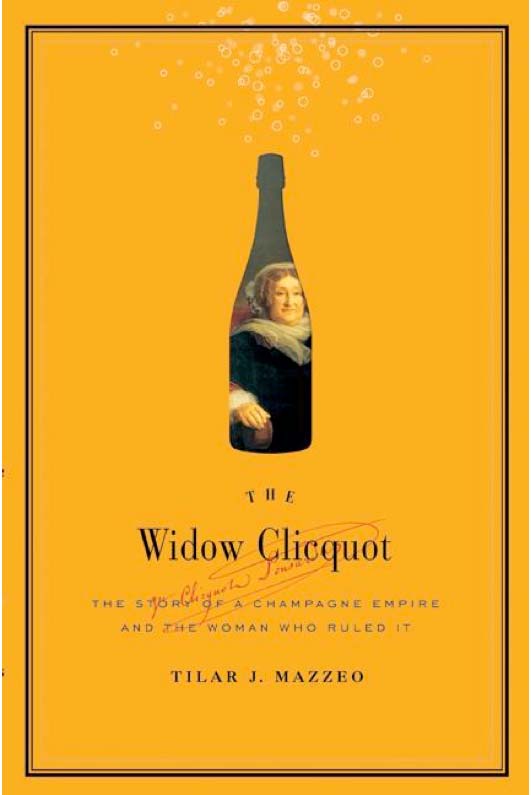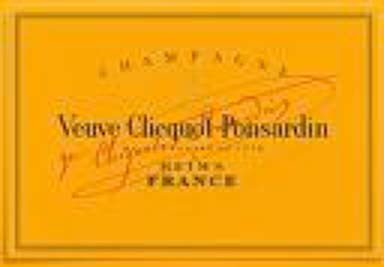Book Review: The Widow Clicquot
On Brian Loring’s home page for Loring Wine Company he says, “Is there anything worth drinking other than
Pinot Noir and Champagne?” I would agree completely except I would add Chardonnay to the mix.
Champagne is truly a refreshing libation but it has a number of benefits beyond its taste including a lower
alcohol (most Champagnes contain less than 13% alcohol), the absence of significant sulfites, and a palate cleansing
effervescence. Revered and highly enjoyable, Champagne is probably one of the least understood
wines in the world.
A new book, The Widow Clicquot: The Story of a Champagne Empire and the Woman who Ruled It, provides a
significant body of valuable information for those wanting to learn more about Champagne. Written by Tilar J.
Mazzeo, PhD, this is a scholarly treatise that traces the story of Barbe-Nicole Clicquot Ponsardin, the Grand
Lady of Champagne, in the context of the history of Champagne from its origins in England in the 1670s to the
1800s when Champagne became big business. Widowed at the age of 27 with absolutely no business training,
Veuve (or Widow) Clicquot transformed a small family wine brokerage into one of the most significant
Champagne houses of the 19th century in a little over a decade. By the age of 40, she was one of the
wealthiest business entrepreneurs and richest middle class women in all of Europe.

Upon the death of her husband, Francois Clicquot , Barbe-Nicole Clicquot Ponsardin joined Alexandre Jerome
Fourneux in a business partnership in 1806 and founded Veuve Clicquot Fourneaux & Co.. She immediately
took an active role in the business, participating in the crafting of her own Champagne and within four years
was in charge of the business which became Veuve Clicquot Ponsardin & Co.. The Widow Clicquot’s risky
decision to arrange to transport her wines from the 1811 or “comet” vintage to Russia for sale after the fall of
Napoleon saved her company and led to the internationalization of Champagne. She continued at the helm of
Veuve Clicquot Ponsardin & Co. until 1841, when at the age of 64 she retired. To this day, Champagne Veuve
Clicquot Ponsardin is the only elite Champagne house with a woman (Madame Cécile Bonnefond) at the helm.
In the 1800s everyone knew of the Widow Clicquot, but few understand anything about the woman behind the
yellow label. Scant details of her life have been preserved. Her personal letters did not survive and there is
little biographical record. It is to the author’s credit that she was able to recreate the life story and provide new
insight about this unique woman. Mazzeo does write at times with considerable speculation, but her grasp of
history makes the whole story very plausible. The book has extensive scholarly references and bibliography,
but only one photo of the Widow Clicquot in her later years and no photos of early Champagne bottles or
labels.
This book is valuable for the educational information about Champagne that is interjected throughout its pages.
Here are just a few of the little known facts about Champagne that I learned:
• Champagne was discovered by the British, not the French. Sparkling wine appeared in England by the
1660s, decades before it was sold in France. Wine was shipped from France to England in wooden casks.
The British wanted to better preserve the wine so they put the wine in bottles where the wine underwent a
secondary fermentation. The British added sugar to the bottles, creating Champagne by the 1670s, a decade
before it was produced in France.
• Early on, in the 1790s, Champagne was a dessert wine, very sweet, served cold and brownish pink in color
due to added brandy and skins of grapes. There were only blanc de noirs (white and red grapes).
• Dom Pierre Perignon did not invent Champagne. That was a marketing ploy by the region’s Champagne
producers at the 1889 World Exhibition in Paris. In reality, Dom Perignon was given the task of getting rid of
bubbles that were ruining still wines of the time. A secondary fermentation occurred in wines stored over the
winter in sealed wood casks and when the weather warmed in the spring, a secondary fermentation occurred
creating bubbles in the so-called “devil’s wine.” There was little market for sparkling wine at the time. Dom
Perignon was a pioneer of blending.
• The older a Champagne is, the smaller the bubbles become. Bubbles do not affect taste. Since vintage
Champagne is aged extensively creating smaller bubbles, the quality of high quality Champagne is often
attributed to small bubbles.
• Vintage Champagne must be aged a minimum of 3 years, some of the best are aged 7-8 years. After
disgorgement, Champagne rarely improves with cellaring.
• The Widow Clicquot discovered remuage, a system of clearing Champagne yeast debris trapped in the bottle
after secondary fermentation by riddling.
• Barbe-Nicole Clicquot was one of the first winemakers to use labels on her bottles
in 1814.
• The signature of Barbe-Nicole Clicquot is on every orange label Champagne that
bears her name.
The Widow Clicquot: The Story of a Champagne Empire and the Woman Who Ruled It is published by Harper
Collins Publishers, softcover, 255 pages, $25.95
The 1988 Veuve Clicquot Rare Vintage Recently Disgorged Champagne is now available ($96.99). This
wine, which is from a great vintage, was originally released in 1997, but a portion was held back and recently
disgorged. It is 1/2 Chardonnay and 1/2 Pinot Noir and Pinot Meunier. The price is very modest considering the
age and pedigree of this Champagne and the wine press has been effusive about its stellar quality.




